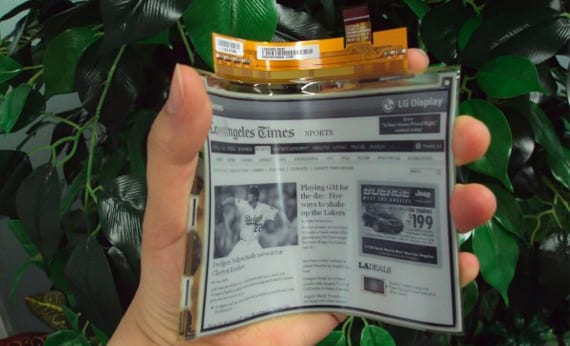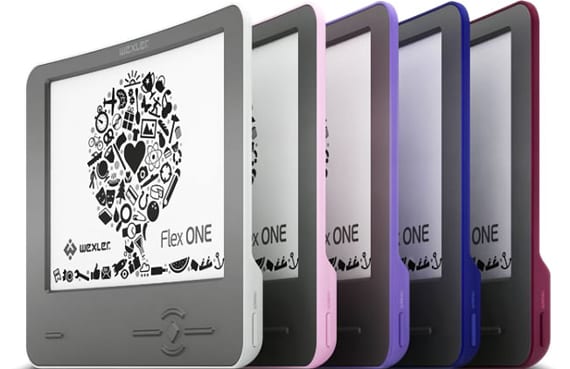
Not long ago we were talking on the blog of PaperTab, the flexible e-ink tablet that Plastic Logic is developing, whose prototype presented at CES 2013, and that even if it was only a prototype seemed to offer numerous possibilities.
LG had already announced in March 2012 that the production of a flexible e-ink display that I expected to have on sale during the month of April 2012. I do not know to what extent it will be coincidence that these two companies (and others) saw the flexible electronic ink screen as an option for the future, but it is still a interesting discussion point.
LG offered a 6 ″ shatterproof plastic screen with a resolution of 768 × 1024 pixels, in the same range as the HD screens that are currently being offered in some of their Kindle, Kobo or Onyx models; all this together with a weight of 14 grams and a thickness of 0,7 mm could have meant a significant improvement in terms of weight and performance in electronic readers.
The operation, in a very simple way, each capsule would contain a liquid in which the black and white particles float that would be attracted or repelled depending on the electrical charge, thus showing each point in white, black or gray. So far, there is not much difference with any other common screen.

Before LG, there were similar attempts by Samsung or Philips and, as we have already said, the most recent prototype is the Plastic Logic. This type of flexible screen has also been used in readers like the WEXLER.Flex ONE, an expensive reader if we take into account the benefits (a bit scarce) that it offers.
In the case of Plastic Logic, the most interesting option it presents is the possibility to combine different screens so that it becomes a very versatile device in terms of size. The combination of screens allows us to view files in real size, really appreciate how they would look printed, use "add-on" applications simultaneously, and so on.
On the other hand, the WEXLER.Flex ONE offered us a reader with some normal benefits pulling loose for the price it had. A basic reader, although very correct, with the novelty of the flexible screen, a novelty that had to be paid for.
From the possibilities posed by the various manufacturers, the one that seems most tempting to me is the one offered by Plastic Logic. I find the option of being able to combine screens to change the size in which you see the document is extremely attractive: for a book - one screen, for a pdf in A4 with illustrations - two screens, a manga - one screen; It is really interesting (at least until we know the price).
The success of this idea, as well as color electronic ink, front-lit screens, the tablet-reader combination, or any of the innovations proposed by manufacturers, depends on public acceptance; So as users I ask you a few questions:
- What progress do you think the use of these screens in electronic readers or tablets would mean?
- Would you be interested?
- What applications do you see?
- Better for tablet or e-reader?
- Would you combine it with other technology? With which?
I advance my opinion: for the concept that we have (or that I have) of electronic reader as a substitute for the paper book I do not find it very useful. If I just want to read, I can use a device like any of the ones we use now, lightweight, that does not harm my sight, with a large storage capacity to have my library at hand ...
However, the idea of the flexible screen never ceases to appeal to me. for its lightness and versatility that my imagination sees the idea of Plastic Logic. It is precisely that idea that seems to me the greatest advance: the ability to combine several screens depending on the use you want to give it.
And already set to curl the curl, I would combine it with a color electronic ink (of higher quality than the one we have found so far, of course) and you would have the ideal tablet since you could use it as much as you wanted with less battery consumption, with numerous applications, you could read comics or fiction books, documents with numerous illustrations or formulas, in the light of day, without reflections, and all this without tiring my eyes.
This is my idea. Which is yours?
More information - PaperTab, a flexible e-ink tablet
Sources - WEXLER.Flex ONE, Expansión newspaper, Les Numeriques
It might be a good thing to place an e-ink screen under a clear OLED screen.
It makes me "funny" (rather it makes me sad) to remember that news a year ago that LG was going to sell flexible screens ... in the end the thing came to nothing. Although it is not my greatest desire in an ereader (color is rather) if it would have applications ... imagine an ereader with a flexible screen (difficult to break, let's go), with quality color electronic ink (good contrast), about 10 ″ and weeks of battery life ... can you imagine? It could be goodbye to textbooks and heavy school bags. One of those devices for each kid and that's it ... one last time. When? I know that the technology is there… why doesn't anyone dare to take the step?
Someone commented on it in another post, I think I remember. The technology is there, but it is as if companies want to exhaust what there is and then, if that, someone takes the step, feel the market and if it is not given very hard, we will all go behind.
Not that I said it like that, but the idea could very well be that.